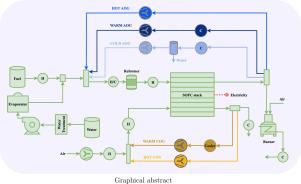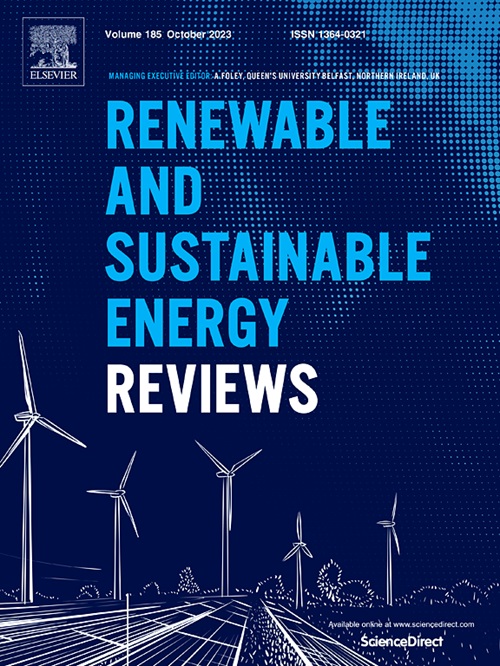Analysis and optimization of solid oxide fuel cell system with anode and cathode off gas recirculation
IF 16.3
1区 工程技术
Q1 ENERGY & FUELS
引用次数: 0
Abstract
Solid oxide fuel cell technology shows great potential in generating electricity. However, insufficient steam in the stack can result in carbon deposition, accelerating cell degradation over prolonged operation. To prevent this, ensuring an adequate supply of external water is necessary, yet resulting in a larger external water purification unit and a greater need for heat for water evaporation. Anode-off gas, which comprises unreacted fuel, steam and CO from the stack, can be strategically recirculated to the external reformer inlet, preventing carbon deposition in the reformer and stack. Further, solid oxide fuel cell system offers the potential to supply high-temperature heat to industrial applications, embodying the concept of combined heat and power plants. To maximize heat availability, cathode-off gas can partially be blended with the fresh air entering the stack. Various anode-off gas and cathode-off gas recirculation configurations are possible, and they have to be systematically analysed and compared. This study models all possible system configurations using different types of anode-off gas (no, cold, warm, hot) and cathode-off gas (no, warm, hot) recirculations. Multi-objective optimization has been conducted, and system performance has been analysed and compared using electrical efficiency, freshwater consumption, thermal efficiency, design complexity, heat availability and heat valorization potential. Further, an in-depth analysis of the impact of decision variables on the objective functions has been performed for different system configurations. These valuable insights serve as a guide to engineers and decision-makers, enabling informed decisions for solid oxide fuel cell system design.

阳极和阴极废气再循环固体氧化物燃料电池系统的分析与优化
固体氧化物燃料电池技术在发电方面具有巨大潜力。然而,烟囱中的蒸汽不足会导致碳沉积,在长期运行过程中加速电池降解。为了避免这种情况,必须确保外部有足够的水供应,但这会导致外部水净化装置的增大和水蒸发对热量的更大需求。阳极废气包括未反应的燃料、蒸汽和来自烟囱的二氧化碳,可以有计划地再循环到外部重整器入口,防止碳沉积在重整器和烟囱中。此外,固体氧化物燃料电池系统还可为工业应用提供高温热能,体现了热电联产的概念。为了最大限度地提供热量,阴极废气可与进入烟囱的新鲜空气部分混合。各种阳极废气和阴极废气再循环配置都是可能的,必须对它们进行系统分析和比较。本研究使用不同类型的阳极废气(无、冷、暖、热)和阴极废气(无、暖、热)再循环,对所有可能的系统配置进行建模。研究进行了多目标优化,并利用电能效率、淡水消耗、热能效率、设计复杂性、热能利用率和热能增值潜力对系统性能进行了分析和比较。此外,还针对不同的系统配置,深入分析了决策变量对目标函数的影响。这些宝贵的见解为工程师和决策者提供了指导,使他们能够在固体氧化物燃料电池系统设计方面做出明智的决策。
本文章由计算机程序翻译,如有差异,请以英文原文为准。
求助全文
约1分钟内获得全文
求助全文
来源期刊

Renewable and Sustainable Energy Reviews
工程技术-能源与燃料
CiteScore
31.20
自引率
5.70%
发文量
1055
审稿时长
62 days
期刊介绍:
The mission of Renewable and Sustainable Energy Reviews is to disseminate the most compelling and pertinent critical insights in renewable and sustainable energy, fostering collaboration among the research community, private sector, and policy and decision makers. The journal aims to exchange challenges, solutions, innovative concepts, and technologies, contributing to sustainable development, the transition to a low-carbon future, and the attainment of emissions targets outlined by the United Nations Framework Convention on Climate Change.
Renewable and Sustainable Energy Reviews publishes a diverse range of content, including review papers, original research, case studies, and analyses of new technologies, all featuring a substantial review component such as critique, comparison, or analysis. Introducing a distinctive paper type, Expert Insights, the journal presents commissioned mini-reviews authored by field leaders, addressing topics of significant interest. Case studies undergo consideration only if they showcase the work's applicability to other regions or contribute valuable insights to the broader field of renewable and sustainable energy. Notably, a bibliographic or literature review lacking critical analysis is deemed unsuitable for publication.
 求助内容:
求助内容: 应助结果提醒方式:
应助结果提醒方式:


